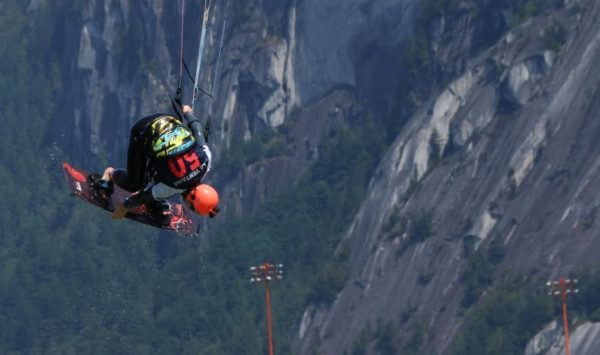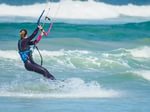Kiteboarders in Squamish, B.C., say they are being left high and dry as the date to remove the Squamish Spit in an effort to save dwindling salmon stocks moves closer.
The long, man-made berm that reaches into Howe Sound at the mouth of the Squamish River has become a renowned recreational destination thanks to its excellent accessibility and consistent thermal winds.
But beneath the bright sails and blue water, the spit is blocking salmon fry exiting the Squamish River from reaching their nursery grounds in the river estuary
Kiter Rebecca Aldous says she believes the plan to remove a major portion of the spit as early as 2021 has not adequately considered the impacts of losing a world-class sporting amenity. She’s started a petition under the title “Save Access to Canada’s Premier Kiteboarding Location.”
“The one thing we really wanted to get through in this petition is just how this issue is so much bigger than Squamish, this really is a premier water sports location in Canada,” she said. “It would really be losing a national treasure for water sports.”
Guaranteed access
Aldous says she understands why the spit is being removed, but kiteboarders would like guaranteed access to whatever the new configuration is.
In 2017, the Squamish River Watershed Society, in partnership with Fisheries and Oceans Canada and the Squamish Nation, was awarded funding of $5 million to improve fish habitat and access, especially for juvenile chinook salmon in the Squamish River estuary.

SRWS executive director Edith Tobe said the project is part of the effort to save the southern resident killer whales who rely on chinook salmon as their main food source.
Tobe says her group has no comment on the petition but stressed that the estuary restoration project has been developed with the input of the Squamish Windsports Society and District of Squamish.
“We have had numerous meetings since 2017 … including an all day workshop held this past Friday on Feb. 28 in which three member of the Squamish Windsports Society board were in attendance,” she said.
According to the SRWS, the spit creates a flushing effect where the Squamish River meets Howe Sound, shooting chinook fry into the ocean before they’re mature enough to survive.
The group believes removing or realigning the spit would allow the fry better access to the estuary where they would normally grow before heading to the ocean.
Aldous says there are alternatives that could satisfy the kiters — including a building pier, a pedestrian bridge or shortening the spit — but none have been explored because of the project’s rushed funding timeline.
She warns if nothing is put in place, the estuary will face a different risk from kiters who will inevitably walk through it with all their gear to access the water.
“If you take it away, it’s going to be a free for all,” she said.
‘A unique and loved location’
According to DFO, the chinook salmon population in the Squamish River dropped from about 19,000 before the Spit was constructed in the 1970s, to a low of 500 in the mid-1980s. Restorations efforts have restored the population to about 5,000 in recent years.
In an email, Squamish Windsports Society president Geoffrey Waterson said he was encouraged by the support from kiteboarders.
“Kiteboarders from around the world have reached out to us as a result of the petition and it clearly shows that this is a unique and loved location,” Waterson said.
He said that removing a large section of the spit will create “new and unusual challenges,” but he expects that if funding can be secured, eventually a berm or walkway will be constructed to reopen access to the area.





Recent Comments